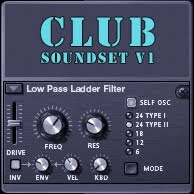
Exode's Club Soundset Vol.1
If you've been making music for long with Propellerhead's Reason chances are you've come across Daniel Olsson, aka Exode's work. His Minimoog inspired refill and Wave Soundscapes series are a few of my favorites, and of course his aptly named Massive Synthesis ReFill is a must have! So when I heard of the release of his new commercial series, the Club Soundset Trilogy, I couldn't wait to check it out. Now first off, while these refills are called "Club Soundsets" I think these patches could really be used in anything from Pop to Hip Hop to of course Dance music. For this review we are going to concentrate on my favorite of the three refills Volume 1! Let's break down what's in this set:
Combinators:
60+ combinator patches. Now while I generally like my patches broken down into different folders for each instrument, Exode has identified each patch with a two letter code at the start of each name. BS for bass, FX for effects, LD for lead, PD for pads, SQ for sequences (arpeggios), and SY for general synth patches. The Pads are my favorite here. "PD - Frozen Electronics" is just beautiful! This patch uses two Thors, 6 oscillators in total, run into a line mixer with a Scream unit set to "Digital" on the send channel. The Mod Wheel opens up the Frequency on the four of the six State Variable Filters this patch uses.
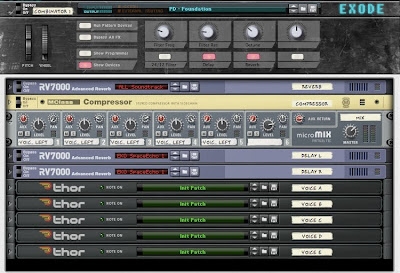
Another standout is "PD - Foundation" which uses 18 square wave analog oscillators to create a thick bed of sound that works great for chords. The Leads here are fantastic as well and I learned a new sound design tip when studying them - the patch "LD - Clouds" uses two Thor synths with one square wave Multi-Oscillator each run in tandem mono into a compressor for a wide stereo width sound. This same technique is used to great effect in the patch "SQ - Limit Break". This arpeggiator patch "dances" around the stereo field thru a lush Hall reverb algorithm. One final patch I'd like to mention in the combinator folder is "BS - Core" a 10 oscillator bass monster that really screams when you raise the resonance! Like most of the patches this one has well thought out controls for stereo spread (Rotary 4), detune (Rotary 3), resonance (Rotary 2) and frequency (Rotary 1); as well as buttons for switching the Filter to high pass and engaging a stereo multi-tap delay.
Kong:
Next up are the Kong Kits, 12 to be precise - 192 unique sounds (Hey Ma, look I can do math!) Exode manages to coax a variety of sounds out of the 7 different Physical Modeling and Synth Designer Drum Modules in Kong. These kits are broken down into "Electro", "Energetic", "Hard" and "Trance". The "Electro" kits really stand out in my mind. They have that classic drum machine sound that I absolutely love!
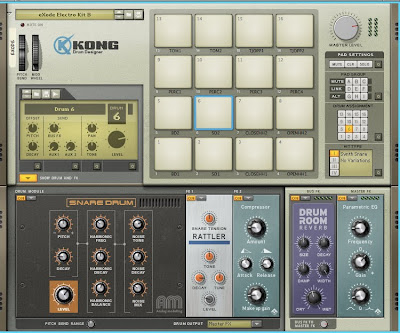
The "Energetic" kits have a Hip Hop sound to my ears, which is a good thing. "Hard" is exactly that, mean sounding drums. Watch your speakers on these ones! The "Trance" kits have that classic 90s dance sound that hit the mainstream in the early aughts. Of course Kong has more than just synth modeling and Exode also uses the NN-Nano Sampler to great effect on these kits. I was so impressed with these samples that I had to ask Daniel where they came from:
"The samples are all from my own private library, most of them were actually designed with the devices in Reason and then exported as samples, edited and put inside the Nano."
Thor:
The biggest folder of instruments in Club Soundset Vol.1 is labelled "Thor", and pardon the analogy, but Exode really brought the thunder here (I apologize for that, really.) But seriously I counted well over 100 unique instruments! And these aren't the ones used to make up the sounds in the Combinator folder like you find in a lot of refills. I was particularly impressed with the Bass patches here, everything from Minimoog and MS style basses to more modern digital mayhem. All labelled with monikers that will easily identify what kind of sound the patch will give you (i.e. "Big Taurus", "MS Style", "Vintage Bass", etc.)
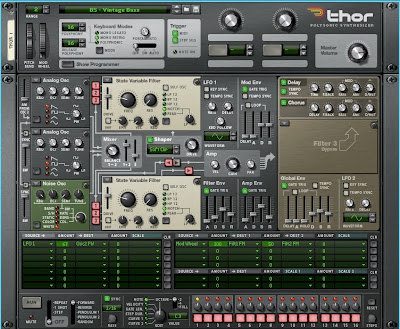
The Thor folder uses the same two letter coded system identifying patch categories as the Combinators; with the addition of two categories: KY for keys (with some great organ sounds, "Wurli" being my favorite of the bunch) and RH, which kind of lost me as far as what it stands for, but suffice to say these patches use Thor's step sequencer (which for amateur keyboardist like myself are always great for one finger fun ;-). One thing I will mention about the Thor folder is I would have liked all the patches to have mapped knobs and buttons on the main faceplate, but Exode is only one guy and I can only imagine how long it must have taken to design all these incredible sounds. With all these different patches it got me thinking about how Exode can continue creating such stellar patches. So I sent him an e-mail with a few questions:
You've created some of my favorite sounds for Reason, from the Moog Tribute Refill to Voltage Controlled to the all encompassing Massive Synthesis. With such a substantial body of work how do you continue creating new and unique sounds? Do you worry about whether a sound/patch might be similar to something you've already released?
"a. God knows really. Maybe it's because I try to develop new ideas and techniques all the time, even at my level you still learn new stuff and I use that knowledge and apply it to my work.
b. It's not a very advertised fact but for instance some of the patches in Club Soundset V1 use a technique to get an asymmetric BP filter as well as something I would call a 24db HP Ladder filter. I wrote a tutorial on that technique on the PUF a while back. I also have some patches in V3 that use LFO1 as a fourth oscillator, also something I wrote a tutorial on.
c. I do worry about sounds being similar occationally, but then I think that even if a patch is similar to something I've released before, people will realise that it's not intentional (or at least I hope they do!)."
The Club Soundsets Vol.1 ReFill might just be my favorite release of yours yet. Lush pads, meaty basses, killer Kong kits and soaring leads - it really covers every sound you'd need to create a banging club hit! Where did the inspiration come for this refill? Are you a big fan of dance music?
"The inspiration definitely came from dance music but I also had a set goal for this refill and that was to create sounds that could compete with popular VSTi's such as Sylenth1 and Dune. I've always had a weak spot for different types of dance music, especially trance, israeli and psytrance."
I had the pleasure of interviewing you back in November of 2009 for Resonant Filter and at the time you said that you had become more moderate in your use of effects in patches. I noticed while playing with Club Soundsets Vol.1's combinator patches that you used effects quite generously and effectively on many of the sounds. Was this a conscious decision on your part or is that just what the patches called for?
'Yes, that is true, I guess I have come full circle! No, but seriously I should have given that statement some more thought because there are applications where you might need more effects, it's not black and white. For the combinator patches in Vol.1. it was very much a conscious decision because I think it's what these type of sounds are about. Big sounds with heavy processing fit the dance genre well and it also kept in line with my goal of showing that Reason can sound just as good and big as other popular VST's. The effects helped me to that goal."
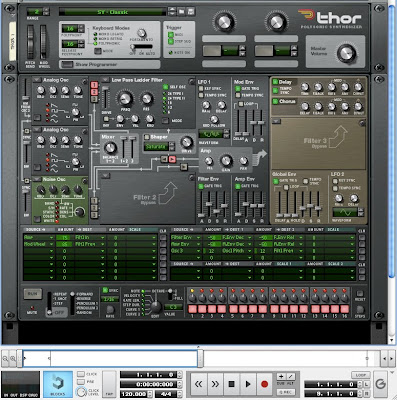
As a budding sound designer myself I learn so much from studying your patches. For example in Club Soundsets Vol.3's SY_Classic Patch you use a White Noise Oscillator to moderately modulate the pitch of an Analog Square Wave Oscillator and the frequency of a Low Pass Filter. This gives the patch a hint of the White Noise sound as well as a slightly out of tune sound reminding me a bit of Boards of Canada. This is something I never would of thought to do, but I'll certainly be using the idea now ;-). Where do you get your new sound design ideas from?
"a. For some time now I've had the philosophy of incorporating random elements to some of my patches to make them less perfect and a bit more organic. The idea of using noise as a modulation source and applying it to filter and osc freq came from when I programmed my Tetra (Dave Smith Instruments). Because the Tetra has digital controlled oscillators they are perfectly in tune. I used this trick to make the Tetra less perfect and a little more noisy!
b. I usually get my ideas from my own mind or by looking at other peoples patches, I think there's no harm in learning techniques from other sound designers, in fact it's a very good method of learning, as long as you don't steal their work obviously. Finally, owning a modular synthesizer helps envision stuff that I hadn't thought about before because the way you work with CV and interact with the instrument is very direct when compared to software that make use of a mod matrix or similar."
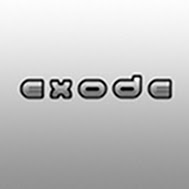
Verdict:
Great sounds that cover multiple genres of music, from Dance to Pop to Hip Hop! I see this refill as being useful to a few different folks - the aspiring sound designer will definitely learn a thing or two studying the patches, the composer will appreciate the coded system Exode employed to quickly identify the instruments, and finally the rest of us will just plain dig the spectacular sounds!
Exode's Club Soundset Vol.1 can be purchased for €25.00 from:
exodesound.bigcartel.com/product/club-soundset-part-1.
Buy it today!

No comments:
Post a Comment